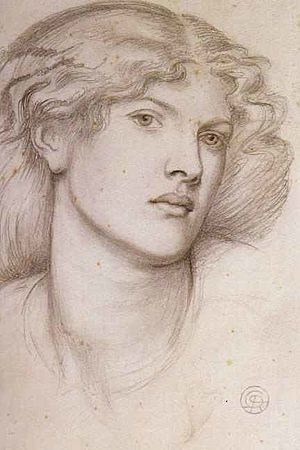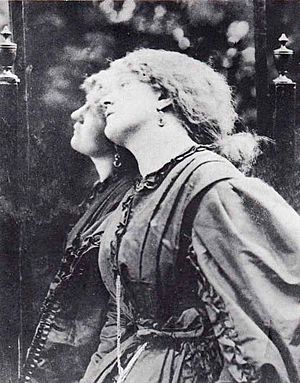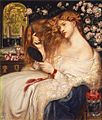Fanny Cornforth facts for kids
Quick facts for kids
Fanny Cornforth
|
|
|---|---|

Fanny Cornforth by Dante Gabriel Rossetti c 1865 Pencil on paper
|
|
| Born |
Sarah Cox
3 January 1835 |
| Died | 24 February 1909 (aged 74) Graylingwell Hospital, Chichester, England
|
| Known for | Model (art), Housekeeper (servant) |
|
Notable work
|
Portrayed by Rossetti many times in pencil on paper; less frequently in red chalk (sanguine), 1860s and 1870s. Also model for Edward Burne-Jones and J. R. Spencer Stanhope. |
| Movement | Pre-Raphaelites |
Fanny Cornforth (born Sarah Cox; 1835 – 1909) was an English artist's model. She was a very important model and housekeeper for the famous Pre-Raphaelite painter Dante Gabriel Rossetti. Fanny was known for her unique look in Rossetti's paintings. She looked different from his other models like Alexa Wilding, Jane Morris, and Elizabeth Siddal.
Contents
Fanny Cornforth's Life Story
Early Years and Family Background
Fanny Cornforth was born Sarah Cox on January 3, 1835. Her birthplace was Steyning, in Sussex, England. Her father, William Cox, was a blacksmith. As a young person, she worked as a house servant in Brighton. This was recorded in the 1851 census.
Working with Dante Gabriel Rossetti
Cornforth met Rossetti in 1856. She became his main model and later his housekeeper. Many people thought Rossetti's wife, Elizabeth Siddall, did not like Fanny. However, there is no proof that Elizabeth even knew about her. Fanny's first job was to model for the head of a painting called Found. She later said Rossetti "put my head against the wall and drew it for the head of the calf picture."
Three months after Rossetti's wedding, Fanny married a mechanic named Timothy Hughes. But their marriage did not last long, and they separated. It is not clear when she started using the name "Fanny Cornforth." Cornforth was the last name of her first husband's stepfather.
After Elizabeth Siddall passed away in 1862, Fanny moved into Rossetti's home. She worked there as his housekeeper. Their close working relationship continued until Rossetti's death. Rossetti also had a connection with Jane Morris, who was married to his friend William Morris. While that relationship was private, his connection with Fanny was well-known.
Fanny came from a working-class background. Her accent and lack of formal education surprised Rossetti's friends and family. Rossetti's brother, William Michael Rossetti, admired her beauty. But he also said she lacked "charm of breeding, education, or intellect." Many people did not accept her. They often pressured Rossetti to end their close connection.
Over time, both Rossetti and Fanny gained weight. This became a funny inside joke between them. He called her "My Dear Elephant," and she called him "Rhino." When they were apart, he would draw elephant cartoons for her. He often signed them "Old Rhinoceros."
Later Life and Second Marriage
As Rossetti's health got worse, his family became more involved in his life. Fanny had to leave Rossetti's house in 1877. Rossetti paid for a house for her nearby. He wrote to her, "You are the only person whom it is my duty to provide for." He also gave her several of his paintings. He made sure she had legal proof that they belonged to her.
Fanny's first husband died in 1872. While she was separated from Rossetti, she met John Schott. He was a publican, which means he owned a pub. John Schott married Fanny in November 1879. They ran a pub called the Rose tavern in London.
Even after her second marriage, Fanny often returned to care for Rossetti. She went with him to Cumbria in 1881. After Rossetti passed away, Fanny and her husband opened a gallery in 1883. They sold some of the artworks Rossetti had given her. Her husband John died in 1891. After that, she lived with her stepson Frederick.
During this time, a collector named Samuel Bancroft visited her. He bought paintings and other items from her. Her letters to Bancroft are now kept at the Delaware Art Museum.
Final Years and Passing
After her stepson died in 1898, Fanny moved back to Sussex. She stayed with her husband's family. By 1905, she seemed to be suffering from dementia. Her sister-in-law, Rosa Villiers, took care of her. Rosa placed her in a workhouse in West Sussex.
On March 30, 1907, Fanny was admitted to the West Sussex County Lunatic Asylum. Hospital records show she had "senile mania," which means confusion and memory problems. She stayed at the asylum for the rest of her life. After a fall in 1907, her health declined. She passed away on February 24, 1909, at age 74, from pneumonia. She was buried in a common grave paid for by the asylum.
Fanny Cornforth's Role in Art
Fanny Cornforth was a very important model for the Pre-Raphaelite art movement. She posed for about 60 oil paintings, watercolors, pastels, or pencil drawings by Rossetti.
Some of her famous appearances in Rossetti's art include:
- Bocca Baciata (1859)
- Fanny Cornforth, a graphite drawing (1859)
- Lucrezia Borgia (1861)
- Fair Rosamund (1861)
- Fazio's Mistress (Aurelia) (1863–1873)
- The Blue Bower (1865)
- Lady Lilith (1867), the first version. Later, Rossetti changed the face to another model, Alexa Wilding.
- Found (1869), which was never finished.
A small, round oil painting from 1862, now at the Royal Academy in London, is a simple portrait of Fanny. This was unusual for Rossetti.
Fanny also modeled for other artists, such as:
- Sidonia von Bork, by Edward Burne-Jones (1860)
Images for kids






